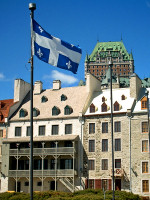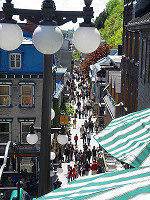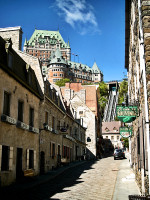|
Situated on and around a cliff
overlooking the St. Lawrence River as it winds its
way through French Canada, Ville de Québec
(or Quebec City) is the closest thing to a European
City that you’ll find in North America. The Algonquin
referred to the area as kebek meaning “narrowing
of the river”, and it was here that Samuel Champlain
established the permanent settlement in 1608. The
stone buildings and narrow streets around the Place
Royale at the base of the cliff constitute the lower
town portion of Vieux-Québec and still project
a feel of New France. We wandered out from our B&B
and strolled around the sunny lanes looking in shops
and ducking into the odd outdoor café to nurse
a beer or two.
There are two ways to head
to the upper part of the old city – the funicular
or the many stairs – so it was an easy decision, especially
after a few beers on a warm day, to take the short
ride up. The massive boardwalk atop the cliff known
as the Dufferin Terrace offers a fabulous view of
the lower town, the river, and the Île d’Orléans.
The skyline of the upper town is dominated by the
patina-roofed Château Frontenac, an exquisite
hotel dating back to the turn of the century. It was
here where Churchill and Roosevelt planned the Normandy
invasion in 1943. As the sun began to fade on our
first day, we kicked back in the big leather club
chairs at the château’s St. Laurant Bar and
did a little planning of our own.
The following day was graced
with the same cloudless sky, so we explored more of
the upper town. We toured the Citadelle which defended
Quebec City from invasion for years until it fell
to the British for good during the French and Indian
War (or the Seven Years War as it was known to the
European participants). While the French commander
Montcalm was focusing his attention on protecting
the lower city, the British general Wolfe had his
men scale the cliffs to the north and march on the
Citadelle. The European foes clashed on the Plains
of Abraham outside the city's fortifications with
the French eventually being overwhelmed. As a consequence
of the war’s outcome, France ceded most of its Canadian
possessions to the British Empire; however, the Quebec
Act some years later guaranteed the French inhabitants
the rights to retain their language and religious
freedom. Today the Plains are maintained as a city
park. The highlight of the trip occurred that evening
with a fine québécois dinner at the
famous Restaurant aux Anciens Canadiens where we dined
on caribou with blueberry cream sauce and the mixed
grill plate of stag, caribou, and buffalo with cognac
sauce.
|

The fleurs-de-lis fly over the
site of the original settlement.

A view of the lower town from
Breakneck Stairs.

A view from the old town.
|